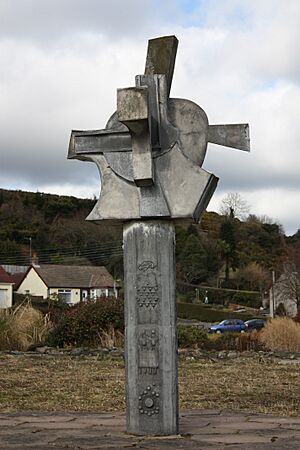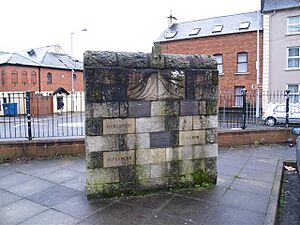Bob Sloan facts for kids
Quick facts for kids
Bob Sloan
HRUA, ARBS
|
|
|---|---|
| Born | 10 April 1940 Belfast
|
| Education | Belfast College of Art |
| Alma mater | Central School of Art & Design |
| Known for | Sculpture & education |
| Style | Abstract |
Bob Sloan (born in 1940) is a famous artist from Northern Ireland. He creates amazing sculptures, paintings, and special art installations. He is a respected member of the Royal Ulster Academy of Arts, where he has won many gold and silver medals for his art. Bob Sloan's artwork has been shown all over the world, and he is especially known for his sculptures. He also helped lead the Sculptors Society of Ireland for a few years. In the 1970s, he even built his own art foundry (a place to melt and shape metal) in his studio! Bob Sloan has also taught many young artists, helping them learn and grow.
Bob Sloan's Early Life
Robert W. Sloan was born in Belfast on April 10, 1940. His dad was an upholsterer (someone who works with furniture fabric), and his mom was a school cook. He grew up in Belfast, near the Donegall Pass and Ormeau Road areas. Bob remembers being inspired by watching blacksmiths (people who work with metal) fixing horseshoes and cart wheels.
He went to Annadale Grammar School from 1952 to 1959. There, he was taught by Kenneth Jamison, who later became the Director of the Arts Council of Northern Ireland.
Bob then studied art at the Belfast School of Art from 1959 to 1963. He learned from famous artists like Romeo Toogood and Tom Carr. After that, he went to the Central School of Art and Design in London from 1963 to 1964. In London, he visited many art galleries and was inspired by sculptures from artists like Pablo Picasso and Edgar Degas. He couldn't finish his course because it was too expensive, so he started working part-time as a teacher. It was during this time that he met his future wife, Vicky.
Bob Sloan's Art Career
In 1965, Bob Sloan moved back to Northern Ireland. He started working at Lisnagarvey High School in Lisburn. At the same time, he opened his own art studio in Lisburn and began showing his artwork. He moved his studio to Carryduff in 1969.
In 1971, he became the Head of Art at Parkhall Integrated College in Antrim, a job he kept until 1974. Then, in 1974, he became a lecturer (a type of teacher) at the Ulster University at Jordanstown.
In 1974, Bob had a show at the Arts Council of Northern Ireland Gallery. He showed drawings and pastels. Because there weren't many places to cast (shape metal) art in Northern Ireland, Bob decided to build his own casting facilities in the late 1970s. He used these until 1982.
He traveled to North America several times, visiting art conferences and workshops. These trips inspired him to make his foundry even bigger, with help from the Arts Council of Northern Ireland. His trips also showed him new ideas for large sculptures from artists like Nancy Holt and Mark di Suvero.
In 1977, Bob took part in a special art event in Germany called Documenta 6. He created performance and installation art there. In 1979, he showed two new sculptures: Even Smaller Dancer (made of aluminum) and Confined (made of brass). The next year, he showed his work Crois Cheilteach for the first time.
In 1982, Bob Sloan had two solo art shows. One was at the Arts Council of Northern Ireland Gallery, where he showed some of his "site-specific" works. These are artworks made for a particular place. The other show was at the Tom Caldwell Gallery in Dublin. Sadly, the Arts Council show had to close early because of an explosion nearby that damaged the building and his art.
A month before this, on March 17, 1982, his large metal cross sculpture in Downpatrick was officially revealed.
Throughout the 1980s, Bob had many solo shows at different galleries in Belfast and Craigavon.
Bob Sloan has shown his art regularly at the Royal Ulster Academy of Arts annual exhibitions since 1982. He won the Academy's silver medal in 1983, and gold medals in 1990 and 1999. In 1998, his "Self-Portrait" sculpture, made of wax and lead, won a prize for Best Self-Portrait. People said it was a "stunning achievement."
He became an Associate of the Royal Ulster Academy in 1990 and then an honorary Academician in 1995. He also worked as a Director for the Sculptors' Society of Ireland from 1988 to 1991. In 1991, a gallery in Waterford held a special show of all his sculptures.
In 2001, Bob Sloan was one of sixteen Belfast artists invited to show their work at the Waterfront Hall. This was part of the Belfast International Arts Festival. Two years later, Bob received a special request from Lisburn City Council to create a sculpture for a public art trail along the River Lagan. This sculpture, called Tree of Dreams, is nine meters tall and made of stainless steel. It has five thousand copper leaves, each with a hope or wish written on it by people from the Lisburn area.
In recent years, Bob has also shown his work in group exhibitions, like A Northern Light in Galway. He continues to create art from his studio in Carryduff, near Belfast.
Bob Sloan's Legacy
Bob Sloan's artwork can be found in many important collections around the world. These include the Ulster Museum, the Arts Council of Northern Ireland, the Arts Council (Ireland), and The National Self-Portrait Collection of Ireland. His art is also part of the Royal Ulster Academy Diploma Collection.



